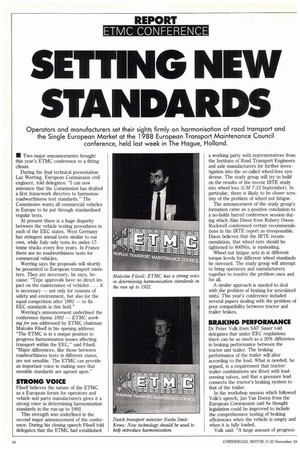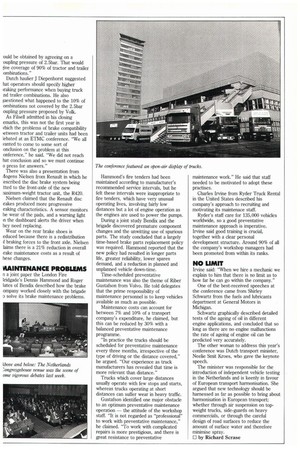SETTING NEW STANDARDS
Page 40

Page 41

If you've noticed an error in this article please click here to report it so we can fix it.
Operators and manufacturers set their sights firmly on harmonisation of road transport and the Single European Market at the 1988 European Transport Maintenance Council conference, held last week in The Hague, Holland.
• Two major announcements brought this year's ETMC conference to a fitting climax.
During the final technical presentation Luc Werring, European Commission civil engineer, told delegates: "I can now announce that the Commission has drafted a first framework directive to harmonise roadworthiness test standards." The Commission wants all commercial vehicles in Europe to be put through standardised regular tests.
At present there is a huge disparity between the vehicle testing procedures in each of the EEC states. West Germany has stringent annual tests similar to our own, while Italy only tests its under-17tonne trucks every five years. In France there are no roadworthiness tests for • commercial vehicles.
Werring says the proposals will shortly be presented to European transport ministers. They are necessary, he says, because: "Type approvals have no direct impact on the maintenance of vehicles . . . it is necessary — not only for reasons of safety and environment, but also for the equal competition after 1992 — to fix EEC standards in this field."
Werring's announcement underlined the conference theme 1992 — ETMC working for you addressed by ETMC chairman Malcolm Filsell in his opening address: "The ETMC is in a unique position to progress harmonisation issues affecting transport within the EEC," said Filsell. "Major differences, like those between roadworthiness tests in different states, are not sensible. The ETMC can provide an important voice in making sure that sensible standards are agreed upon."
STRONG VOICE
Filsell believes the nature of the ETMC as a European forum for operators and vehicle and parts manufacturers gives it a strong voice in determining harmonisation standards in the run-up to 1992, This strength was underlined in the second major announcement of the conference. During his closing speech Filsell told delegates that the ETMC had established a working party with representatives from the Institute of Road Transport Engineers and axle manufacturers for further investigation into the so-called wheel-loss syndrome. The study group will try to build on the results of the recent IRTE study into wheel loss (CM 7-13 September). In particular, there is likely to be closer scrutiny of the problem of wheel nut fatigue.
The announcement of the study group's formation came as a positive conclusion to a no-holds barred conference session during which Alan Dixon from Rubery OwenRockwell condemned certain recommendations in the IRTE report as irresponsible. Dixon believes that the IRTE recommendation, that wheel nuts should be tightened to 800Nm, is misleading.
Wheel nut fatigue sets in at different torque levels for different wheel standards he stressed. The study group will attempt to bring operators and manufacturers together to resolve the problem once and for all.
A similar approach is needed to deal with the problem of braking for articulated units'. This year's conference included several papers dealing with the problem of poor compatibility between tractor and trailer brakes.
BRAKING PERFORMANCE
Dr Peter Volk from SAF Sauer told delegates that under EEC regulations there can be as much as a 20% difference in braking performance between the tractor and trailer. The braking performance of the trailer will alter according to the load_ What is needed, he argued, is a requirement that tractor/ trailer combinations are fitted with loadsensing valves, and that a pressure lead connects the tractor's braking system to that of the trailer.
In the workshop session which followed Yolk's speech, Jan Van Doorp from the European Commission said he thought legislation could be improved to include the comprehensive testing of braking efficiencies when the vehicle is empty and when it is fully loaded.
Volk said: "A large amount of progress :ould be obtained by agreeing on a :oupling pressure of 2.5bar. That would ;ive coverage of 90% of tractor and trailer :ombinations."
Dutch haulier J Diepenhorst suggested hat operators should specify higher waking performance when buying truck nd trailer combinations. He also pestioned what happened to the 10% of ombinations not covered by the 2.5bar nupling pressure proposed by Volk.
As Filsell admitted in his closing emarks, this was not the first year in vhich the problems of brake compatibility retween tractor and trailer units had been lebated at an ETMC conference. "We all canted to come to some sort of onclusion on the problem at this onference," he said. "We did not reach hat conclusion and so we must continue o press for answers."
There was also a presentation from 4ogens Nielsen from Renault in which he lescribed the disc brake system being ttted to the front-axle of the new riaximum-weight tractor unit, the R420.
Nielsen claimed that the Renault disc Takes produced more progressive Taking characteristics. A sensor monitors he wear of the pads, and a warning light n the dashboard alerts the driver when hey need replacing.
Wear on the rear brake shoes is educed because there is a redistribution braking forces to the front axle. Nielsen laims there is a 21% reduction in overall Take maintenance costs as a result of hese changes.
RAINTENANCE PROBLEMS
a a joint paper the London Fire lridgade's Dennis Hammond and Roger kites of Bendix described how the brake ompany worked closely with the brigade D solve its brake maintenance problems. Hammond's fire tenders had been maintained according to manufacturer's recommended service intervals, but he felt these intervals were inappropriate to fire tenders, which have very unusual operating lives, involving fairly low distances but a lot of engine operation as the engines are used to power the pumps.
During a joint study Bendix and the brigade discovered premature component changes and the unwitting use of spurious parts. The study concluded that a largely time-based brake parts replacement policy was required. Hammond reported that the new policy had resulted in longer parts life, greater reliability, lower spares demand, and a reduction in planned and unplanned vehicle down-time.
Time-scheduled preventative maintenance was also the theme of Riber Gustafson from Volvo. He told delegates that the prime responsibility of maintenance personnel is to keep vehicles available as much as possible.
Maintenance costs can account for between 7% and 10% of a transport company's expenditure, he claimed, but this can be reduced by 30% with a balanced preventative maintenance programme.
"In practice the trucks should be scheduled for preventative maintenance every three months, irrespective of the type of driving or the distance covered," he argued. "Our experience as truck manufacturers has revealed that time is more relevant than distance."
Trucks which cover large distances usually operate with few stops and starts, whereas trucks operating at short distances can suffer wear in heavy traffic.
Gustafson identified one major obstacle to an optimum preventative maintenance operation — the attitude of the workshop staff. "It is not regarded as "professional" to work with preventative maintenance," he claimed. "To work with complicated repairs is more prestigious, and there is great resistance to preventative maintenance work." He said that staff needed to be motivated to adopt these practises.
Charles Irvine from Ryder Truck Rental in the United States described his company's approach to recruiting and motivating its maintenace staff.
Ryder's staff care for 135,000 vehicles worldwide, so a good preventative maintenance approach is imperative. Irvine said good training is crucial, together with a clear personal development structure. Around 90% of all the company's workshop managers had been promoted from within its ranks.
NO UMIT
Irvine said: "When we hire a mechanic we explain to him that there is no limit as to how far he can go within the company."
One of the best-received speeches at the conference came from Shirley Schwartz from the fuels and lubricants department at General Motors in Michigan.
Schwartz graphically described detailed tests of the ageing of oil in different engine applications, and concluded that so long as there are no engine malfunctions the rate of ageing of engine oil can be predicted very accurately.
The other woman to address this year's conference was Dutch transport minister, Neelie Smit Kroes, who gave the keynote speech.
The minister was responsible for the introduction of independent vehicle testing in the Netherlands and is keenly in favour of European transport harmonisation. She argued that new technology should be harnessed as far as possible to bring about harmonisation in European transport; whether through air suspension on topweight trucks, side-guards on heavy commercials, or through the careful design of road surfaces to reduce the amount of surface water and therefore minimise spray.
El by Richard Scrase


























































